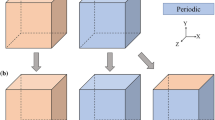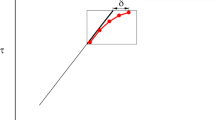Abstract
A framework based on FFT is proposed for micromechanical fatigue modeling of polycrystals as alternative to the Finite Element method (FEM). The variational FFT approach (de Geus et al. in Comput Methods Appl Mech Eng 318:412–430, 2017; Zeman et al. in Int J Numer Methods Eng 110:903–926, 2017) is used with a crystal plasticity model for the cyclic behavior of the grains that is introduced through a FEM material subroutine, in particular an Abaqus umat. The framework also includes an alternative projection operator based on discrete differentiation to improve the microfield fidelity allowing to include second phases. The accuracy and efficiency of the FFT framework for microstructure sensitive fatigue prediction are assessed by comparing with FEM. The macroscopic cyclic response of a polycrystal obtained with both methods were indistinguishable, irrespective of the number of cycles. The microscopic fields presented small differences that decrease when using the discrete projection operator, which indeed allowed simulating accurately microstructures containing very stiff particles. Finally, the maximum differences in the fatigue life estimation from the microfields respect FEM were around 15%. In summary, this framework allows predicting fatigue life with a similar accuracy than using FEM but strongly reducing the computational cost.









Similar content being viewed by others
Abbreviations
- \(\Omega _0\) :
-
Domain in reference configuration
- \(\mathbf {x},\varvec{\xi },\varvec{\alpha }\) :
-
Vectors \(x_{i},\xi _{i},\alpha _{i}\)
- \(\mathbf {P},\mathbf {F},\varvec{\tau }\) :
-
Second-order tensors \(P_{ij},F_{ij},\tau _{ij}\)
- \(\mathbb {C},\mathbb {G},\mathbb {K}\) :
-
Fourth-order tensors and operators \(C_{ijkl},G_{ijkl},K_{ijkl}\)
- \(\mathbf {A}=\mathbf {F}^T\) :
-
Tensor transpose \(A_{ij}=F_{ji}\)
- \(\mathbf {A}=\varvec{\tau }\mathbf {F}\) :
-
Dot product \(A_{ij}=\tau _{ip}F_{pj}\)
- \(a=\mathbf {F}:\mathbf {P}\) :
-
Double dot product \(a=F_{ij}P_{ij}\)
- \(\mathbf {P}=\mathbb {C}:\mathbf {F}\) :
-
Double dot product \(P_{ij}=C_{ijkl}F_{kl}\)
- \(\mathrm {Div} \ \mathbf {P}\) :
-
Divergence of tensor field in the reference configuration \(\frac{\partial P_{ij}}{\partial X_j}\)
- \(G *P\) :
-
Convolution operation
- \(I_{ijkl}\) :
-
Fourth order identity tensor \(I_{ijkl}=\delta _{ik}\delta _{jl}\)
References
de Geus TWJ, Vondejc J, Zeman J, Peerlings RHJ, Geers MGD (2017) Finite strain FFT-based non-linear solvers made simple. Comput Methods Appl Mech Eng 318:412–430
Zeman J, de Geus TWJ, Vondrejc J, Peerlings RHJ, Geers MGD (2017) A finite element perspective on nonlinear FFT-based micromechanical simulations. Int J Numer Methods Eng 110:903–926
McDowell DL, Dunne FPE (2010) Microstructure-sensitive computational modeling of fatigue crack formation. Int J Fatigue 32(9):1521–1542
Pineau A, McDowell DL, Busso EP, Antolovich SD (2016) Failure of metals II: fatigue. Acta Mater 107:484–507
Segurado J, Lebensohn RA, LLorca J (2018) Computational homogenization of polycrystals. Adv Appl Mech (submitted)
Herrera-Solaz V, LLorca J, Dogan E, Karaman I, Segurado J (2014) An inverse optimization strategy to determine single crystal mechanical behavior from polycrystal tests: application to AZ31 Mg alloy. Int J Plast 57:1–15
Cruzado A, Gan B, Jimenez M, Barba D, Ostolaza K, Linaza A, Molina-Aldareguia JM, Llorca J, Segurado J (2015) Multiscale modeling of the mechanical behavior of IN718 superalloy based on micropillar compression and computational homogenization. Acta Mater 98:242–253
Cailletaud G (1992) A micromechanical approach to inelastic behaviour of metals. Int J Plast 8(1):55–73
Cruzado A, LLorca J, Segurado J (2017) Modeling cyclic deformation of inconel 718 superalloy by means of crystal plasticity and computational homogenization. Int J Solids Struct 122:148–161
Shenoy M, Zhang J, McDowell DL (2007) Estimating fatigue sensitivity to polycrystalline Ni-base superalloy microstructures using a computational approach. Fatigue Fract Eng Mater Struct 30:889–904
McDowell DL, Dunne FPE (2010) Microstructure-sensitive computational modeling of fatigue crack formation. Int J Fatigue 32:1521–1542
Sangid MD (2013) The physics of fatigue crack initiation. Int J Fatigue 57:58–72
Zhang T, Jiang J, Shollock BA, Britton TB, Dunne FPE (2015) Slip localization and fatigue crack nucleation near a non-metallic inclusion in polycrystalline nickel-based superalloy. Mater Sci Eng A 641:328–339
Castelluccio GM, McDowell DL (2014) Mesoscale modeling of microstructurally small fatigue cracks in metallic polycrystals. Mater Sci Eng A 598:34–55
Cruzado A, Lucarini S, LLorca J, Segurado J (2018) Microstructure-based fatigue life model of metallic alloys with bilinear Coffin–Manson behavior. Int J Fatigue 107:40–48
Moulinec H, Suquet P (1998) A numerical method for computing the overall response of nonlinear composites with complex microstructure. Comput Methods Appl Mech Eng 157(1):69–94
Eisenlohr P, Diehl M, Lebensohn RA, Roters F (2013) A spectral method solution to crystal elasto-viscoplasticity at finite strains. Int J Plast 46:37–53
Kabel M, Merkert D, Schneider M (2015) Use of composite voxels in FFT-based homogenization. Comput Methods Appl Mech Eng 294:168–188
Monchiet V, Bonnet G (2013) Numerical homogenization of nonlinear composites with a polarization-based FFT iterative scheme. Comput Mater Sci 79:276–283
Lebensohn RA, Escobedo JP, Cerreta EK, Dennis-Koller D, Bronkhorst CA, Bingert JF (2013) Modeling void growth in polycrystalline materials. Acta Mater 61(18):6918–6932
Lebensohn RA, Cazacu O (2012) Effect of single-crystal plastic deformation mechanisms on the dilatational plastic response of porous polycrystals. Int J Solids Struct 49(26):3838–3852
Lebensohn RA (2001) N-site modeling of a 3D viscoplastic polycrystal using fast fourier transform. Acta Mater 49(14):2723–2737
Lebensohn RA, Liu Y, Ponte Castaneda P (2004) On the accuracy of the self-consistent approximation for polycrystals: comparison with full-field numerical simulations. Acta Mater 52(18):5347–5361
Willot F (2015) Fourier-based schemes for computing the mechanical response of composites with accurate local fields. CR Mec 343(3):232–245
Rovinelli A, Lebensohn RA, Sangid MD (2015) Influence of microstructure variability on short crack behavior through postulated micromechanical short crack driving force metrics. Eng Fract Mech 138:265–288
Vondrejc J, Zeman J, Marek I (2010) Matlab implementation of FFT-based solver for numerical homogenization accelerated by conjugate gradients. Czech Technical University, Praha
Michel JC, Moulinec H, Suquet P (1999) Effective properties of composite materials with periodic microstructure: a computational approach. Comput Methods Appl Mech Eng 172(1):109–143
Hestenes MR, Stiefel R (1952) Methods of conjugate gradients for solving linear systems. J Res Natl Bur Stand 49(6):409–436
Kaasschieter EF (1988) Preconditioned conjugate gradients for solving singular systems. J Comput Appl Math 24(1):265–275
Willot F, Abdalla B, Pellegrini YP (2014) Fourier-based schemes with modified green operator for computing the electrical response of heterogeneous media with accurate local fields. Int J Numer Methods Eng 98(7):518–533
Portillo D, del Pozo D, Rodriguez-Galan D, Segurado J, Romero I (2017) Muesli: a material universal library. Adv Eng Softw 105:1–8
Quey R, Dawson PR, Barbe F (2011) Large-scale 3D random polycrystals for the finite element method: generation, meshing and remeshing. Comput Methods Appl Mech Eng 200(17):1729–1745
Asaro RJ, Needleman A (1985) Overview no. 42 texture development and strain hardening in rate dependent polycrystals. Acta Metall 33(6):923–953
Manonukul A, Dunne FPE (2004) High- and low-cycle fatigue crack initiation using polycrystal plasticity. Proc R Soc Lond A Math Phys Eng Sci 460:1881–1903
Sweeney CA, McHugh PE, McGarry JP, Leen SB (2012) Micromechanical methodology for fatigue in cardiovascular stents. Int J Fatigue 44:202–216
Sweeney CA, O’Brien B, McHugh PE, Leen SB (2014) Experimental characterisation for micromechanical modelling of CoCr stent fatigue. Biomaterials 35:36–48
Wan VVC, MacLachlan DW, Dunne FPE (2014) A stored energy criterion for fatigue crack nucleation in polycrystals. Int J Fatigue 68:90–102
Sweeney CA, Vorster W, Leen SB, Sakurada E, McHugh PE, Dunne FPE (2013) The role of elastic anisotropy, length scale and crystallographic slip in fatigue crack nucleation. J Mech Phys Solids 61:1224–1240
Castelluccio GM, McDowell DL (2015) Microstructure and mesh sensitivities of mesoscale surrogate driving force measures for transgranular fatigue cracks in polycrystals. Mater Sci Eng A 639:626–639
Segurado J, Llorca J (2013) Simulation of the deformation of polycrystalline nanostructured ti by computational homogenization. Comput Mater Sci 76:3–11
Acknowledgements
This investigation was supported by ITP (Industria de Turbo Propulsores. S. A.), the Comunidad de Madrid through the Grant PEJD-2016/IND-2824 and the Spanish Ministry of Economy and Competitiveness through the project DPI2015-67667-C3-2-R. The authors thank Dr. A. Linaza and Dr. K. Ostolaza from ITP for Their useful advises and to Dr. A. Cruzado (Texas A&M), M. Spinola and Jun Lian Wang for their help in testing and evaluating the FFT code.
Author information
Authors and Affiliations
Corresponding author
Additional information
Publisher's Note
Springer Nature remains neutral with regard to jurisdictional claims in published maps and institutional affiliations.
Appendix: Coupling with Abaqus material user subroutines
Appendix: Coupling with Abaqus material user subroutines
In this appendix, the adaptation of the Abaqus user material subroutine umat to the FFT framework will be presented for a generic non-linear material with internal variables and under finite deformations.
The FFT method needs to evaluate at each iteration the constitutive equation (Eq. 2) for each point as function of the deformation gradient at current and previous time increments, \(\mathbf {F}^{t_k}\) and \(\mathbf {F}^{t_{k-1}}\) respectively, the last value of the internal variables, \(\varvec{\alpha }^{t_{k-1}}\), and the time step \(\delta t\). These values are also inputs of a umat subroutine and are passed from the FFT code to the umat subroutine through the variables DFGRD1,DFGRD0,STATEV and DTIME respectively. After the evaluation, the FFT code needs to recover from the constitutive model the first Piola Kirchhoff stress \(\mathbf {P}^{t_k}\), the value of the state variables at \(t_k\) and the material tangent \(\mathbb {K}\). The umat subroutine provides the Cauchy stress at time \(t_k\) (\(\varvec{\sigma }\)) in the variable STRESS so, the first Piola-Kirchhoff stress is computed from this value and \(\mathbf {F}=\mathbf {F}^{t_k}\) using
with \(J=\det (\mathbf {F})\).
In the case of \(\mathbb {K}\), an exact transformation of the consistent tangent matrix defined in the umat (variable DDSDDE) to the material tangent used by the FFT code is fundamental to preserve in FFT the convergence rate obtained with the user material in a finite element simulation. The material Jacobian that should be defined in a user subroutine at finite strain is the tangent modulus tensor for the Jaumann rate of the Kirchhoff stress, \(\mathbb {C}^{ab}\), a fourth order tensor defined as
where \(\varvec{\tau }\) is the Kirchhoff stress, \(\overset{\nabla }{}\) corresponds to the Jaumann rate and \(\mathbf {w}\) and \(\mathbf {d}\) are the spin tensor and stretch tensor respectively. In the FFT framework, the material tangent needed to define the linear operator of the equilibrium in each iteration (Eq. 16) is defined as
and the objective then is to derive an explicit expression relating both tensors, \(\mathbb {C}^{ab}\) and \(\mathbb {K}\).
Combining the definition of the material tangent in FFT, Eq. (A.3), and Eq. (A.1) it is obtained
Expressing the previous expression (Eq. A.4) in index notation and expanding the derivative of the product in two terms it is obtained
The second term of Eq. (A.5), the derivative of the inverse of a tensor with respect to itself, is given by A.6.
To obtain first term of Eq. (A.5), the expression in derivatives of Eq. (A.2) is multiplied by a small time increment yielding into A.7.
and reordering the equation, the Abaqus tangent can be written as
where \(\delta \mathbf {d}\) and \(\delta \mathbf {w}\) are obtained as function of \(\mathbf {F}\) and \(\delta \mathbf {F}\) by
and
Replacing these expressions Eqs. (A.9) and (A.10) into Eq. (A.8), it is obtained
Now, the Kirchhoff stress is also linearized respect the perturbation of the deformation gradient
If Eq. A.11 is written in index notation, the resulting expression reads as
and comparing the terms of the last two Eqs. (A.12) and (A.13), considering the minor symmetries of \(\mathbb {C}^{ab}\) and the symmetry of \(\varvec{\tau }\), the resulting expression is:
which can be simplified to
Finally, introducing Eq. (A.15) in the definition of the material tangent (Eq. A.5) the final expression for the material tangent used in the FFT approach as function of the Abaqus tangent is given by
Rights and permissions
About this article
Cite this article
Lucarini, S., Segurado, J. On the accuracy of spectral solvers for micromechanics based fatigue modeling. Comput Mech 63, 365–382 (2019). https://doi.org/10.1007/s00466-018-1598-1
Received:
Accepted:
Published:
Issue Date:
DOI: https://doi.org/10.1007/s00466-018-1598-1




